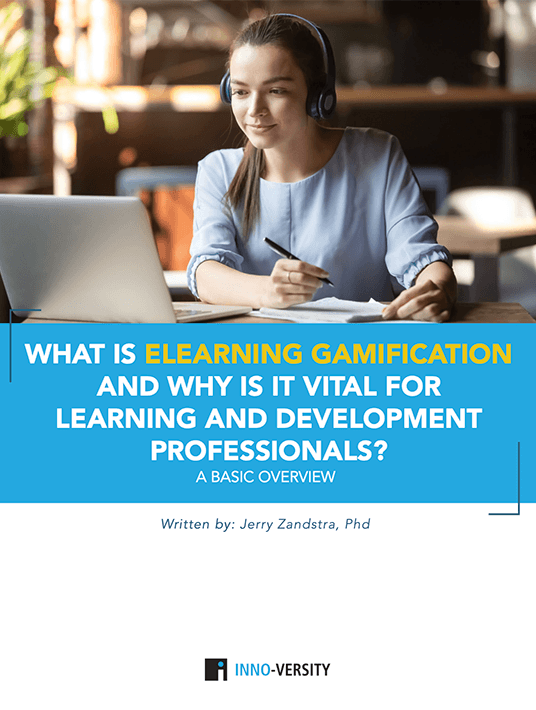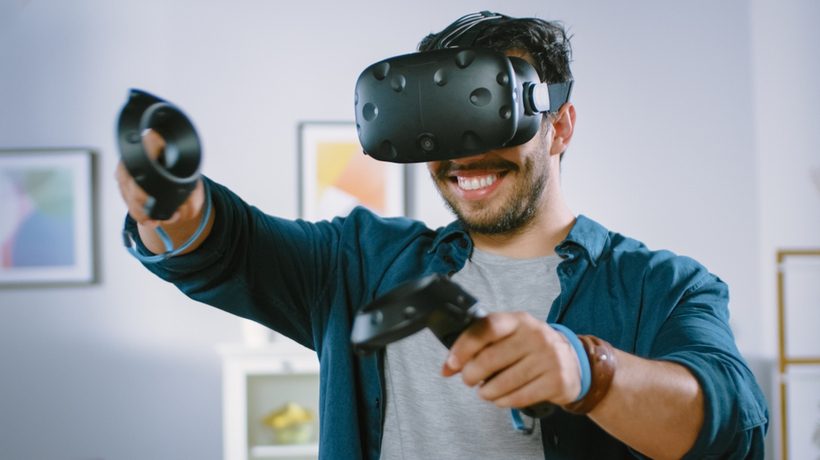Gamification And Virtual Reality
Virtual Reality
Virtual Reality (VR) is a powerful learning tool. It is a simulated digital experience using a headset and motion controllers to create an experience that is similar to or completely different from the real world. Applications are widely used in video games but also for a wide range of learning applications in business, medical, and military training.

VR is, almost by definition, a game. As discussed earlier in this eBook, a game has at least 5 fundamentals: a goal, rules, decision points, mechanics, and feedback. These too are common in Virtual Reality. VR connects easily to the prime motivators of a game in which players can be driven by White Hat or Black Hat motives. It can place a learner in a variety of scenarios and involve puzzles, adventure, role-playing, strategy, action, or simulation.
In this case study drawn from Inno-Versity’s work with law enforcement, we describe how the combination of Virtual Reality, game theory, and learning theory works to produce a world-class learning opportunity for frontline officers and others.
Current Situation, Problem, Or Opportunity
In recent years, Inno-Versity has worked to keep pace with the latest developments of Virtual Reality applications. In all cases, we sought to choose a VR deliverable in situations where it best fits the learning objectives, content, and audience. For VR to be an effective learning tool, strong Instructional Design and learning theory has to be the bedrock on which a VR experience is created. Learning objectives had to remain at the forefront of our minds.
The Challenge
Following our work with clients in a variety of sectors, we decided to develop some situational training that would help law enforcement officers working in any field. We began with clearly defining the problem faced by all levels of law enforcement: live field training. We learned that there is good live training for law enforcement officers and those in degree programs. For a limited number of officers in the military and its Special Forces, very sophisticated VR training models existed. The cost for these complex VR experiences is high and out of the price range for many who need it. The gap we sought to fill for affordable VR was for local law enforcement, state police, security guards, and campus police. They have limited access to live field training and to the sophisticated training available to those in the military. Their training might come from a local community college or technical school with limited live field opportunities and limited budgets.
An additional challenge is the difficulty of simulating the cognitive and sensory issues that happen to people in a live fire situation. It is easy to practice drawing a weapon, aiming, firing, and re-holstering the weapon. It is incredibly more challenging to practice working with a partner or a team to clear a live fire situation or clear a room of an active shooter.
It is extremely difficult to simulate the various cognitive and sensory issues that happen to someone encountering a live fire situation. Those who have been through such a harrowing experience report substantial visual distortion. This happens typically with a blurring of peripheral vision and pinhole focus on just one object while losing awareness of one’s surroundings.
Another common experience is auditory distortion. Some law officers report becoming disoriented by the sheer volume of gunfire and shouting. Others say everything became very quiet. No person reacts the same. In such a situation, officers are often trying to communicate via radio and listen to urgent instructions while trying to pay careful attention to all the details surrounding them.
Some report that time either slows down or speeds up. All these realities cause disorientation and make it difficult to be alert to fast-changing sensory information while trying to make good decisions, protect victims, and protect the officer’s own life. This is why live fire situations are often portrayed in movies and television in slow motion or with tunnel vision. Hollywood is reflecting what often happens to officers in these situations.
The challenge for Inno-Versity was clear. How could we create training that was as close as possible to the actual situation that would create for the learner an experience similar to that of an officer who had been through this dramatic encounter? The objective was clear. We needed a VR game that came as close as possible to the real experience.
The Solution
The goal was to create a VR environment that simulated sensory distortion in sound, sight, and speed of time. We were not looking to create a military-grade virtual experience. We knew our target audience of local law enforcement, security guards, and campus police would not have the budget for that level of training. But we also knew that the VR experience needed to be sophisticated enough to generate real fear. Blood pressure and pulse needed to rise for participants. They needed to experience sensory distortion so that they could practice and learn how to overcome the obstacles of their own mental reaction.
So what did this look like? Let’s start with the overall design of the scenario. Then we will examine the game theory and components that this scenario was built around.
- Participants first enter a VR gun range that functions as the tutorial
Users learn how to look around using the headset, how to move via teleporting with the hand controls, and in general, get comfortable with the device. Users complete several simple tasks that achieve those goals. When those tasks are successfully completed, the VR programs launch the scenario. We found that learning the basic rules and functionality of the game was required before the learner actually began to play. - From the gun range, users receive a call from dispatch to a live—in VR world—shooting
They leave with a partner and head to the scene. They find an office building with a live shooter situation. They must enter the building, successfully clear the rooms of the office with help from a partner. All the while they must avoid injuring a witness while finding and subduing the assailant. All games have goals.
So now, let’s take a look at the definition and game techniques that are applied in this VR scenario.
Game And Motivation Theory Applied
Epic Meaning And Calling
There is a clear, motivating narrative in this scenario that provides context and a higher meaning or calling. The game technique of “humanity hero” is also employed, where the user is motivated to “save the world” by capturing the assailant and saving the witness.
Unpredictability And Curiosity
Within the actual 3-room layout of this scenario, the situation is wildly unpredictable. The gunman could be in any room. A witness enters the scenario and must be recognized and not shot. Additional unpredictability lies within the sensory disorders. The program is written so that any of these disorienting tests can be inflicted on the user. A future goal is to create various levels of each disorder from mild to severe.
Loss And Avoidance
This is the final underlying game theory used in this VR scenario. As the name suggests, it is the fear of losing something or having undesirable events transpire. The storyline of this scenario is clearly aimed at avoiding loss in the most gripping way possible: the loss of life. Specific story elements help create a tension-filled storyline. An urgent dispatch message, a dead victim, a hysterical witness all playing out in dramatic audio create a very real sense of urgency and the desire to avoid any more loss.
The overall goal is to inspire success and mastery. Toward that end, the game technique of "visual grave" was introduced. These are images that make it clear to the learner that they have failed. But they are also inspired to persevere. The learner is motivated by the desire to be successful and win the game. In actual practice, the “visual graves” would be either a dead witness or partner, which means the user failed to subdue the suspect. However, the same scenario can be repeated and the user is encouraged to keep trying. This strengthens their desire to avoid the loss by finding and subduing the suspect.
These theories provide the underlying game and motivational theories. Let’s now dig into the specific game elements that make it so effective.
All games have at least the following elements:
- Rules
These are made clear in the tutorial and must stay within the office environment. - Goal
Learners experience various sensory distortions while in the live shooter situation and practice overcoming obstacles to successfully complete the challenge. - Decision points
While clearing the 3 office rooms, the learner has to make multiple decisions about where to look, what to pay attention to, when to shoot, and when not to shoot. All of these decisions have to be made with the objective of keeping your partner safe and locating the shooter. Everything occurs in the context of sensory distortion. - Mechanics
The program itself is designed to only allow movement into certain areas. If you try to move elsewhere, you find yourself banging into a wall or moving endlessly in circles. - Feedback
Feedback is provided from multiple sources including your partner, dispatch providing auditory cues, and the witness providing auditory feedback. There are several ways for the learner to end the game unsuccessfully; your partner is shot, the learner accidentally shoots the witness, or the learner is shot.
Learning Benefit
Inno-Versity’s Virtual Reality Active Shooter Game allows participants to learn how to avoid sensory distortion without having to go through real-world shoot house training. Participants are able to experience and overcome sensory distortion with diligent practice. By successfully overcoming this in the VR environment, organizations save time and money when participants engage in actual shoot house training and can focus more on the physical aspects.
VR Project from Becci Zwiers on Vimeo.
Conclusion
A few final thoughts. Throughout this process, we worked closely with law enforcement experts who helped us identify what it was like to actually be in an active shooter situation. They are true professionals and we are grateful for their willingness to participate in this training development process as well as their service to our communities. They not only helped in the design, but they also played the game at every level of development. This enabled us to make corrections along the way to give the most accurate experience possible. We continue to get additional feedback from other professionals and will be tracking and measuring the effectiveness of each game theory component and technique as this training gets released to a broader audience.
Download the eBook What Is eLearning Gamification And Why Is It Vital For L&D Professionals? to discover how to bring eLearning gamification to your learning with solid theory and great case studies. Also, join the webinar on the same topic and find out how to create a winning eLearning gamification strategy.


